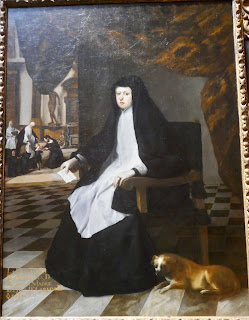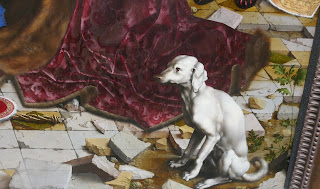Among the pictures I was marvelling at in London’s National Gallery the other day was this one -
 |
| The adoration of the Kings, Jan Gossaert, 1510-15, (Caspar, one of the Three Kings, kneels before the Virgin. Melchior stands behind him, and the black king is Balthasar. The dove of the Holy Spirit descends from the star which guided the kings. Shepherds stand to the right and more appear in the distance.) |
My main interest was the dogs, but it turned out I missed a hidden angel - & so much more. Luckily a BBC Radio 4 programme explained many interesting things about the painting & it can be listened to
here
This picture I didn't even like, except for the dog. I suppose I ought to have been interested because the painter is female, which as we all know is unusual because of the horrible male dominated art world, blah, blah, blah:
 |
| Portrait of a Woman, 1551, by Catharina van Hemessen (The woman carries a small dog under her arm. She is probably from Antwerp in the Low Countries, where the artist painted many similar portraits of women. The sitter's exact identity is unknown.) |
Although I'm not usually wild about Gainsborough, this one I thought lovely - and, at the time, idealised, but since then I have spent ten days in various rural places and discovered that rural England really is this lovely:
 |
| The Market Cart, 1786, by Thomas Gainsborough, (A girl and three younger children are shown returning home from market. Their wagon is laden with fresh produce. The boy gathering sticks for fuel ont he right was included as an afterthought. The position of the horse's head was also altered, making it strain forwards: the old position can be seen where the paint has become transparent with age) |
The dogs just added to the image's appeal:
This couple doesn't appeal to me at all, but their dog redeems them; sometimes I think that is the function of dogs, which is perhaps why so many terrifying people loitering in city streets keep dogs. My cousin's husband believes there is a shop somewhere that sells canine accessories especially for the dogs of itinerants - a collar and lead made out of grubby string, that kind of thing, or possibly a kennel owner who has a long queue of waiting clients for his line of slightly depressed, sandy grey, uncertain breed puppies, each one provided with a rope collar and lead as part of the package:
 |
| Mr & Mrs William Hallett ("The Morning Walk"), 1785, Thomas Gainsborough, (Gainsborough portrayed William Hallett (1764-1842) & Elizabeth Stephen (1763-1833) shortly before their marriage on 30 July 1785. They may be wearing their wedding clothes. Mrs Hallett's silk dress; the white fur of the Pomeranian sheep dog; and the foliage are evoked with the light brushstrokes Gainsborough used in the last phase of his career) |
Stubbs is famed for his horses, but this picture includes a pretty good stab by him at a dog as well
 |
| The Milbanke and Melbourne Families, about 1769, George Stubbs (Elizabeth Milbanke, left, married Peniston Lamb, far right, later First Viscount Melbourne, shortly before this group portrait was painted. She is shown seated in a carriage, perhaps because she was pregnant at the time. The other sitters are, from left, her father Sir Ralph Milbanke and her brother John Milbanke) |
Not that I am arguing about Stubbs's status when it came to painting horses; he was and remains the king in that field:
 |
| Whistlejacket, 1762 George Stubbs, (The racehorse Whistlejacket was painted life size for his owner, the second Marquess of Rockingham, in celebrtation of the Arabian-bred stallion's superb proportions and beautiful appearance. Rockingham's interest in classical sculpture may have inspired this arresting and unusual presentation) |
There is a dog in this picture, but even without one it is extremely intriguing. It seems to be a painting out of its time, faintly surreal and more 1920s than 1750, and I have to add that the inclusion of a third Gainsborough in one post seems to be undermining my claim that I don't like Gainsborough:
 |
| Mr and Mrs Andrews by Thomas Gainsborough (Robert Andrews married Frances Carter in 1748. The couple pose under an oak tree in a field where sheaves of ripe corn have been harvested. The painting of Mrs Andrew's lap is unfinished; the space may have been reserved for a child for Mrs Andrews to hold) |
This painting I definitely wasn't interested in, beyond the chubby pup:
 |
| Portrait of Don Justion de Neve, 1665 by Murillo (The sitter was a canon of Seville Cathedral and a friend and patron of the artist. He obtained a major commission for Murillo, the decoration of the church of Santa Maria la Blanca in Seville) |
This one appealed to me for its subject matter, and the dog was just an added bonus:
 |
| Christ Healing the Paralytic at the Pool of Bethesda, 1667-70, Murillo, (Christ, with three apostles, healed a paralysed man at the pool of Bethesda, (John 5: 2-8) The painting is one of six works by Murillo illustrating the Acts of Charity. They were made for the church of the Confraternity of the Caridad in Seville) |
This one has a background that hints at intrigue and makes one curious - but the dog, ugly as it is, was once again the clincher for me:
 |
| Queen Mariana of Spain in Mourning, 1666, by Juan Bautista Martinex del Mazo, (Queen Mariana was the wife of Philip IV. She acted as Regent from his death in 1665 until 1677, when their son Charles II, reached majority. Charles is shown as a young boy in the background. The widow's dress Mariana wears in this portrait resembles a nun's habit) |
It may seem wrong and frivolous to be focussing on dogs, given the National Gallery's collection has so much more of spiritual edification to offer. I offer as justification the fact that Crufts, the dog show, has just taken place in Birmingham. Of course, this is a time-limited (that dreadful Brexit jargon, it seems to slip into one's brain by osmosis, eurgh eurgh eurgh) justification and I will have to come up with something better when I continue to focus on canines, both back at the National and everywhere else I go to see paintings.
All right, I admit it - I like looking at paintings of dogs.
























No comments:
Post a Comment